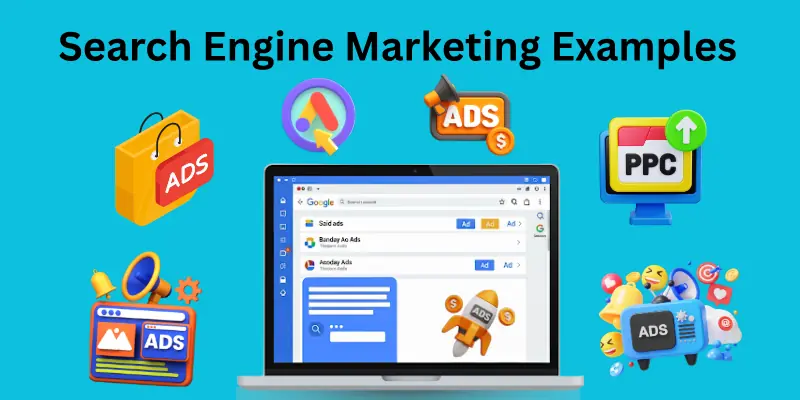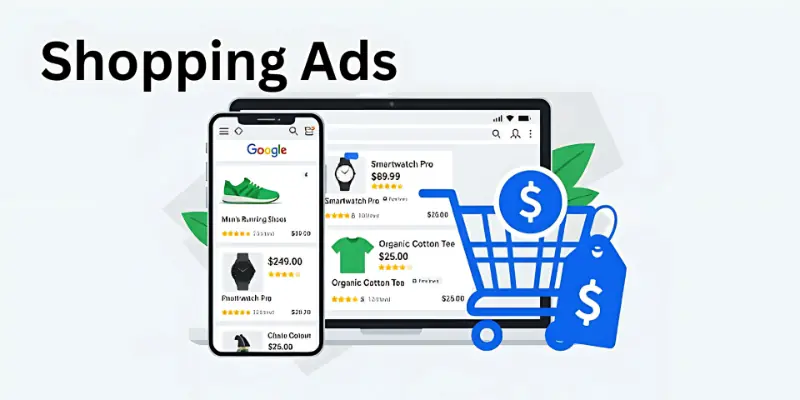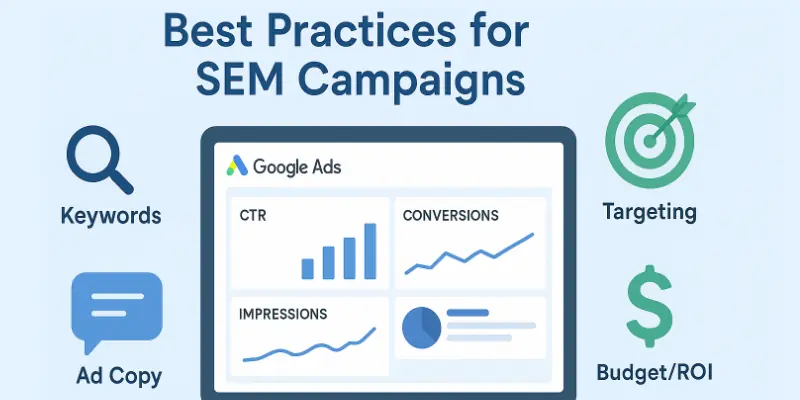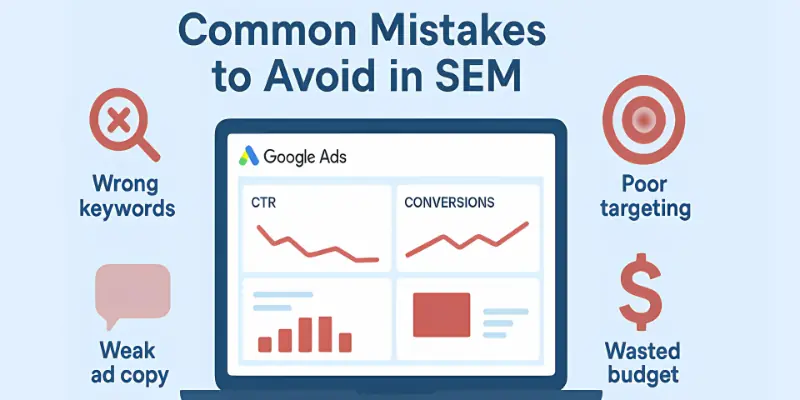11 Search Engine Marketing Examples to Boost Business
Published: 29 Aug 2025
Search Engine Marketing Examples are powerful tools that can help companies to see online. Do you know that more than 4 billion people use the search engine every day? Still, many companies are struggling to appear at the top of the results – why are some ads successful while others are lost? If you find it difficult to attract the right customers, you are not alone. Imagine showing your business properly when someone searches for your product.

In this article, we will find out the proven Search Engine Marketing Examples that show how companies increase visibility, drive traffic, and convert into real sales.
What is Search Engine Marketing(SEM)?
SEM stands for Search Engine Marketing. In simple words, SEM is a way for companies to market their products or services on search engines such as Google or Bing on search engines. Unlike SEO, which naturally focuses on the ranking, Sem allows you to quickly appear at the top of the search results through paid ads.
Main points of SEM:
Here are the main points of Search Engine Marketing(SEM).
- It uses keywords to view ads when people detect related conditions.
- Advertisement for business keywords to compete for placements.
- Advertising can be lessons, photos, or videos.
- Sem helps increase visibility, traffic, management, and sales.
- The results are measurable, so you can track clicks and conversions.
Essentially, SEM is a quick and targeted way to bring your business to those who actively search for you. Let’s now explain these Search Engine Marketing Examples one by one.
✅ List of Search Engine Marketing Examples
Here is a complete list of Search Engine Marketing examples.
- Google Ads (Pay-Per-Click – PPC)
- Bing Ads (Microsoft Ads)
- Shopping Ads (Product Listing Ads)
- Display Ads on Search Networks
- Remarketing Campaigns
- Local Search Ads
- Video Ads (YouTube Ads)
- App Promotion Ads
- Call-Only Ads
- Responsive Search Ads
- Discovery Ads
Let’s explain these Search Engine Marketing examples one by one.
1. Google Ads (Pay-Per-Click – PPC)
Google advertising is the most common sem where businesses pay to appear at the top of the search results.
- Ads appear immediately when users search for specific keywords.
- You only pay when someone clicks on your advertisement.
- Works for all types of businesses, local, online, or global.
- Measure yourself with a place, unit, or type of audience.
- Ads can contain headlines, details, and links.
- The performance can be traced in real time.
- The budget can be adjusted daily or monthly.
- Great for fast visibility and sharp traffic.
2. Bing Ads (Microsoft Ads)
Bing Ads act as Google advertising, but appear on Bing’s search engine and Yahoo’s network.
- Most industries are cheaper than Google ads.
- Low competition means low cost per click (CPC).
- It still reaches millions of users all over the world.
- Advertising can target keywords, demographics, and location.
- The text supports ads, shopping ads, and shows ads.
- Works well for specific target groups (old, professional).
- It is easy to import a campaign from Google Ads.
- Beyond Google is good for businesses seeking excess visibility.
3. Shopping Ads (Product Listing Ads)
Shopping ads show direct products in search results with images, prices, and storage information.

- Example: “Best sneakers” shows the product ad on top.
- Ads include product photos, price, and store names.
- Great to sell good products online for e-commerce companies.
- Helps customers see products before clicking.
- High-quality images increase.
- Accurate details create self-confidence with buyers.
- Advertisements can track sales directly.
- Perfect for online shopping.
4. Display Ads on Search Networks
Perform advertising photos or banner ads displayed at Google’s participant sites in Google’s network.
- Ads appear on blogs, news sites, and apps.
- It may be text-based or visual banners.
- It is good to reach people while surfing the web.
- Marks help to create awareness beyond searches.
- Can target interests, subjects, or websites.
- Works well with eye-catching images and headlines.
- Often cheaper than per-click seek ads.
- Great for retirement or consciousness campaigns.
5. Remarketing Campaigns
Remarketing Campaigns remind people of your products after visiting your site.
- Examples: The ads for the shoes you first show later show.
- Correct those who already know your brand.
- The possibility of sales and conversions is increasing.
- Can view ads on Google, YouTube, or websites.
- Adapt the shopping experience.
- The abandoned shopping works well for wagons.
- Keeping the business on top for customers.
- Very effective for both small and large companies
6. Local Search Ads
Local advertising companies help attract customers who discovered services “near me”.
- Example: A dentist shows the advertisement on the Google map.
- Perfect for small and service-based businesses.
- The ad shows the address, phone number, and instructions.
- Several stores encourage visits and conversations.
- Accurate business information is very important.
- Customers can target themselves within a particular area.
- Increases confidence with reviews and rankings shown.
- Great for restaurants, lounges, clinics, and shops.
7. Video Ads (YouTube Ads)
Video ads are run before YouTube videos to draw attention, in or later.
- Example: A training coach promotes training programs.
- Short, attractive videos work best.
- May include links or call-to-action buttons.
- Perfect for product demo or training.
- A strong brand helps to create an appearance.
- Objective by interest, age, or place.
- Spores visuals, clicks, and conversions.
- The visual creates self-confidence throughout history.
8. App Promotion Ads
These ads encourage people to download or use mobile apps.
- Google Play, YouTube, and search results are displayed.
- Target users are likely to install your app.
- The game works for the tools and service apps.
- Advertising can view screenshots or video previews.
- The app helps to increase downloads rapidly.
- Can track installation and action in the app.
- Budget-friendly for app developers.
- The new app is useful for launch.
9. Call-Only Ads
Call-Online advertising users are designed to call your business directly.
- Only one phone shows the number and the professional name.
- Perfect for service-based businesses.
- The immediate work works well for the needs (plumbing, taxis, doctors).
- Ads appear on mobile search results.
- Pay only when someone taps to call.
- Encourages direct contact with customers.
- Saves time compared to the site trip.
- Want more phones for local businesses.
10. Responsive Search Ads
Responsible search ads automatically test different headlines and details.
- Google mixes headlines and texts to find the best version.
- Helps automatically improve advertising performance.
- More advertising versions save time.
- It is beneficial for different devices and screen sizes.
- The best works with many keywords.
- The possibility of clicks and conversions is increasing.
- The top execution provides insight into the advertising copy.
- Great for new businesses for SEM.
11. Discovery Ads
Discovery ads appear in Gmail, YouTube, and Google Discover Feeds.
- The user feed is designed to look natural.
- Views, rollable, and very attractive.
- Great to reach those who do not seek actively.
- Helps introduce products for new target groups.
- May include images, headlines, and short texts.
- The brand is good for consciousness and product launch.
- Lifestyle works well for fashion and technical brands.
- Traffic can be run on websites or apps.
Best Practices for SEM Campaigns ✅
Following best practices ensures your SEM campaigns deliver the best results:

1. Research the Right Keywords
Choosing the right keywords is the first step to ensure your ads reach the right audience.
- Be aware of the words that really find your customers.
- Use keyword research tools such as Google Keyword Planner.
- Include both keywords with short tail and long tail.
- Think of the search intention: informative, navigation, or transaction.
- Check competing keywords to find opportunities.
- Update the keyword list regularly depending on performance.
2. Write a compelling advertising copy
Your advertising copy will clearly communicate your proposal and draw attention.
- Make your ads clear and easy to read.
- Highlight the main benefits of your product or service.
- Use a language that appeals to your target audience.
- Bring the keywords naturally into the advertising copy.
- Keep in the headlines and away from the attention.
- Finish with a strong call to action for clicks or conversions.
3. Use a strong call-to-action (CTA)🚀
A strong CTA encourages users to take immediate measures.
- Encourage users to take action with sentences such as “Buy now” or “Get a FREE offer”.
- Keep CTA -er at the beginning or end of the advertising copy.
- Use action words such as “download”, “membership”, or “learn more”.
- Match the CTA from the user platform in the procurement process.
- If you visually, the CTA separates using Skjermannsons.
- To see this, test different CTAs that the most clicks are available.
4. Test Multiple Ad Versions (A/B Testing)
Testing different advertising versions helps you find out what works best with the audience.
- Make different headlines and details for the same advertisement.
- If you test different images or views using performance ads.
- Monitor which version gets more clicks or conversions.
- Make small changes at a time to identify what works.
- Use results to improve future campaigns.
- For better performance, conduct A/B testing continuously.
5. Target your ads effectively
Effective targeting ensures that your advertisement is most likely to convert people.
- Be aware of the right place to reach local or global customers.
- Dimensions by device type (mobile, desk, tablet) for better results.
- Use audience targeting on the basis of interests or demographics.
- Adjust targeting settings based on display data.
- Exclude irrelevant target groups to save the budget.
- Mix several targeted options for accuracy.
6. Monitor and optimize regularly
Regular monitoring and adaptation keep your campaigns at their best performance.
- Track clicks, leads, and conversions for each campaign.
- Identify which keywords and ads work best.
- Adjust dialects and budgets depending on the results.
- Stop weak ads to save money.
- Limit targeting to improve public access.
- Keep the campaign tested and updated for continuous growth.
Common Mistakes to Avoid ❌
Avoiding these mistakes will save your SEM campaigns from wasting budget and underperforming.

1. Targeting very wide keywords
Using wide keywords can attract irrelevant traffic and destroy the budget.
- Advertising can show people who are not interested in your product or service.
- The high click volume does not always mean high conversion.
- Extensive keywords are often more expensive per click.
- It makes Roi difficult to measure properly.
- Can attract users outside your target place or audience.
2. To ignore negative keywords
Not using negative keywords can cause wasting advertising.
- Ads appear for findings that are not relevant to your business.
- The total campaign reduces efficiency.
- It can attract users who probably won’t change.
- The budget destroys random clicks.
- Over time, the quality of your ad reduces.
3. Tracking of conversion not
Failing to track conversions means you don’t know which ads work best.
- You cannot assume which keywords generate sales or clients.
- It makes it impossible to adapt to the campaigns effectively.
- Budgets for ads that do not produce results.
- Harap’s understanding of ROI for his campaigns.
- A/B limits data testing.
4. Advertisement quality ignoring
Poor advertising is unable to attract copic clicks and conversions.
- The headlines and details can be unclear or dull.
- Advertising cannot highlight the main benefits of your product/service.
- Weak call-to-action reduces click frequencies.
- Can reduce the total commitment and return.
- Low relevance can cause high cost clicks.
Conclusion 🎯
Search Engine Marketing Examples suggest how businesses of all sizes can reach the right and efficient audience. From Google advertising to remarketing campaigns, each type of unique way to increase visibility provides an increase in traffic and promotes sales. To follow best practices and avoid general mistakes, you can make your SEM campaigns more successful and achieve better results. Whether you are a small business or a big brand, searching for these Search Engine Marketing Examples can help you grow online and achieve your business goals faster.
FAQs
Here are some important FAQs related to Search Engine Marketing Examples.
SEM is a way to market your business online by placing paid ads on search engines like Google or Bing.
Examples include Google Ad, Bing Ad, shopping ad, performance ad, commentary campaign, local search ad, video ad on YouTube, and app campaigns.
SEM quickly uses paid ads to obtain traffic, while SEO focuses on improving your site to systematically rank without paying for clicks.
No. Other platforms such as Bing Ads, YouTube ads, and Google Shopping are also under SEM.
Costs vary depending on keywords, competition, and bid strategy. You can start with a small budget and scale when you see the result.
Yes! Even small businesses can reach their local target groups by using targeted ads, local search operations, and remarketing strategies.
Use tools such as Google Advertising Dashboard, Google Analytics, or Conversion Tracking to monitor clicks, leads, and sales.
Common errors include targeting very wide keywords, ignoring negative keywords, not taking care of conversions, and ignoring mobile users.
Some common Search Engine Marketing Examples include:
Google advertising: I have a local bakery running for “I have the best cake”.
Shopping ad: An online clothing store showing product images and prices in Google Shopping.
Show advertising: Relevant blogs and a travel agency showing banners on websites.
Remarketing campaign: An electronics store that targets users who saw a laptop but did not buy.
Local search ad: A dentist shown in Google Maps for “I have a dentist”.

- Be Respectful
- Stay Relevant
- Stay Positive
- True Feedback
- Encourage Discussion
- Avoid Spamming
- No Fake News
- Don't Copy-Paste
- No Personal Attacks

- Be Respectful
- Stay Relevant
- Stay Positive
- True Feedback
- Encourage Discussion
- Avoid Spamming
- No Fake News
- Don't Copy-Paste
- No Personal Attacks





